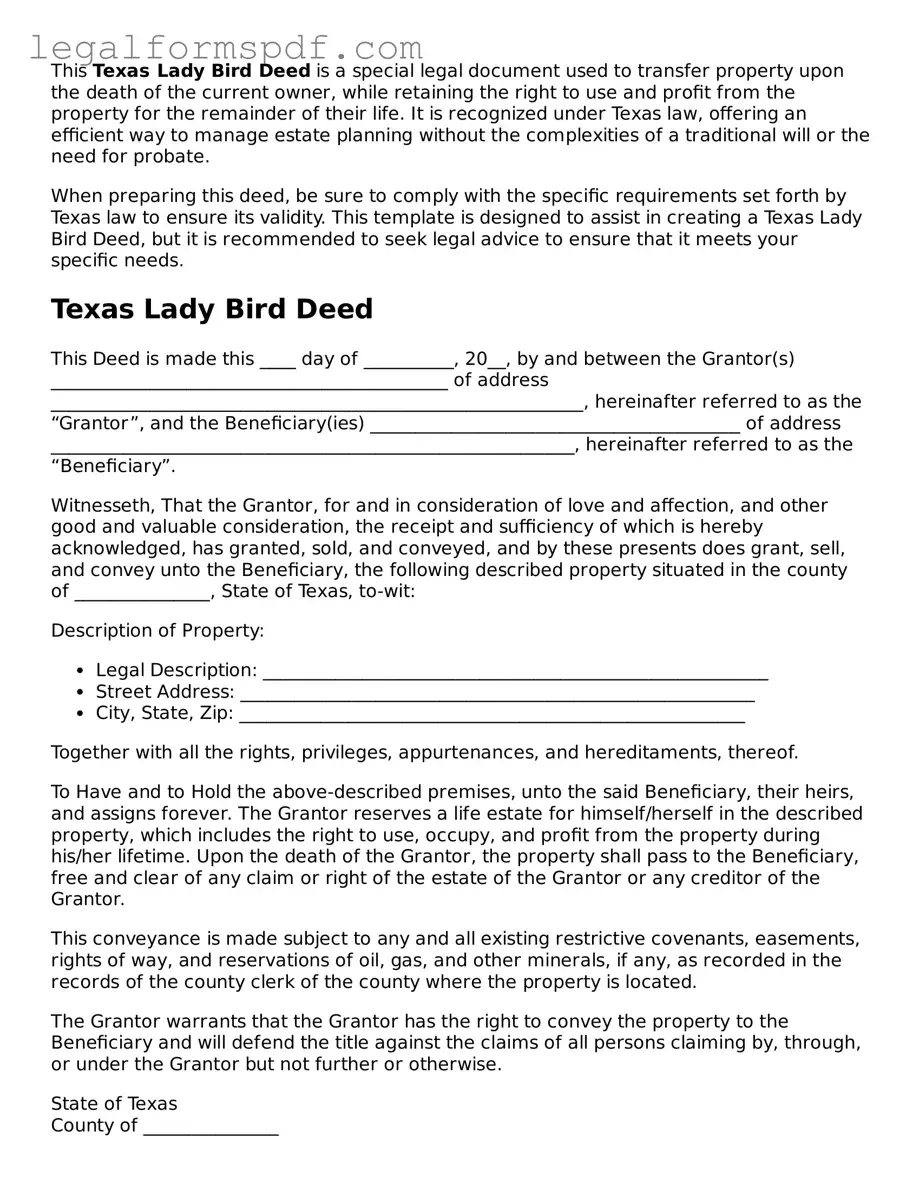This Texas Lady Bird Deed is a special legal document used to transfer property upon the death of the current owner, while retaining the right to use and profit from the property for the remainder of their life. It is recognized under Texas law, offering an efficient way to manage estate planning without the complexities of a traditional will or the need for probate.
When preparing this deed, be sure to comply with the specific requirements set forth by Texas law to ensure its validity. This template is designed to assist in creating a Texas Lady Bird Deed, but it is recommended to seek legal advice to ensure that it meets your specific needs.
Texas Lady Bird Deed
This Deed is made this ____ day of __________, 20__, by and between the Grantor(s) ____________________________________________ of address ___________________________________________________________, hereinafter referred to as the “Grantor”, and the Beneficiary(ies) _________________________________________ of address __________________________________________________________, hereinafter referred to as the “Beneficiary”.
Witnesseth, That the Grantor, for and in consideration of love and affection, and other good and valuable consideration, the receipt and sufficiency of which is hereby acknowledged, has granted, sold, and conveyed, and by these presents does grant, sell, and convey unto the Beneficiary, the following described property situated in the county of _______________, State of Texas, to-wit:
Description of Property:
- Legal Description: ________________________________________________________
- Street Address: _________________________________________________________
- City, State, Zip: ________________________________________________________
Together with all the rights, privileges, appurtenances, and hereditaments, thereof.
To Have and to Hold the above-described premises, unto the said Beneficiary, their heirs, and assigns forever. The Grantor reserves a life estate for himself/herself in the described property, which includes the right to use, occupy, and profit from the property during his/her lifetime. Upon the death of the Grantor, the property shall pass to the Beneficiary, free and clear of any claim or right of the estate of the Grantor or any creditor of the Grantor.
This conveyance is made subject to any and all existing restrictive covenants, easements, rights of way, and reservations of oil, gas, and other minerals, if any, as recorded in the records of the county clerk of the county where the property is located.
The Grantor warrants that the Grantor has the right to convey the property to the Beneficiary and will defend the title against the claims of all persons claiming by, through, or under the Grantor but not further or otherwise.
State of Texas
County of _______________
This document was acknowledged before me on __________ (date) by _______________________________ (name of Grantor).
____________________________________
(Signature of Notary Public)
Notary Public, State of Texas
My Commission Expires: __________________
Prepared by:
____________________________________
(Name)
____________________________________
(Address)
____________________________________
(Phone Number)
This template is provided as a general guide to create a Texas Lady Bird Deed. It's recommended to consult with a legal professional before finalizing the document to ensure it accurately reflects your intentions and complies with current Texas laws.
